View in other NatureServe Network Field Guides
NatureServe
Montana
Utah
Wyoming
Idaho
Wisconsin
British Columbia
South Carolina
Yukon
California
New York
Coronis Fritillary - Argynnis coronis
Native Species
Global Rank:
G5
State Rank:
S5
Agency Status
USFWS:
USFS:
BLM:
External Links
General Description
[From Ferris and Brown 1981; Scott 1986; Glassberg 2001; Pyle 2002] Forewing 2.9-4.0 cm. A mid-sized to large fritillary. Tawny orange to bright orange dorsally, sometimes with postmedian and marginal spots lighter than surrounding ground color, males with light black chains along wing margins, females with heavy black chains; ventral forewing usually reddish-orange flush (especially females), hindwing marginal silver spots inwardly rounded (almost egg-shaped, not tent-like or triangular) and capped with greenish-brown, other underwing silver spots large and round, hindwing disk color brown, submarginal band straw-yellow or pale buff.
Phenology
One flight; June to early September (Scott 1986), early May to mid-October in Oregon and Washington (Pyle 2002; James and Nunnallee 2011), late May to early September east of the continental divide in Colorado (Glassberg 2001).
Diagnostic Characteristics
Distinguished from other large fritillaries by hindwing marginal silver spots inwardly rounded (almost egg-shaped, not tent-like or triangular) and capped with greenish-brown, the underwing submarginal band straw-yellow or pale buff.
Species Range
Montana Range
Range Descriptions
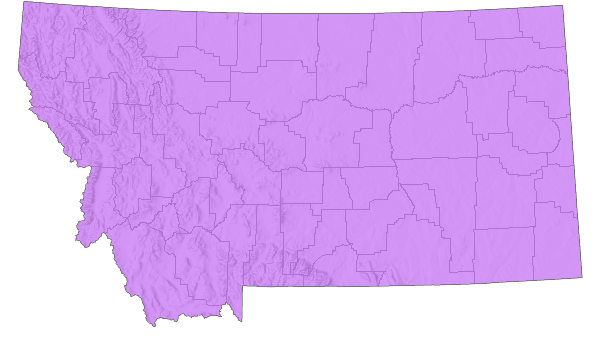
 Native
Native
Range Comments
From northern Washington south to Baja California, east through the Great Basin to the central Rocky Mountains and high Great Plains of Montana, Wyoming and Colorado, and extreme western South Dakota and Nebraska (Scott 1986; Glassberg 2001). To 2770 m elevation in Colorado and Wyoming (Brown 1957; Ferris and Brown 1981), to 2440 m in Oregon and Washington (James and Nunnallee 2011; James and Pelham 2011). In Montana, mostly in the middle third of the state but not recorded in the northern tier of counties adjacent to Canada (Kohler 1980; Stanford and Opler 1993). Uncommon east of the continental divide (Glassberg 2001).
Observations in Montana Natural Heritage Program Database
Number of Observations: 5
(Click on the following maps and charts to see full sized version)
Map Help and Descriptions
Relative Density
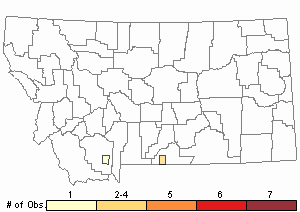
Recency
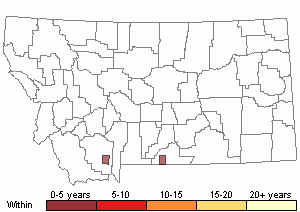
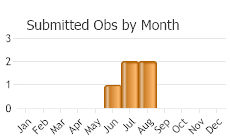
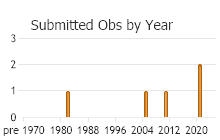
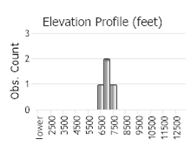 (Observations spanning multiple months or years are excluded from time charts)
(Observations spanning multiple months or years are excluded from time charts)
Migration
Mostly Non-Migratory, but an altitudinal migrant in Oregon coastal lowlands, making elevational movements upslope in midsummer and returning in late summer (Scott 1986). In central Washington the same altitudinal migration reported, mostly by females, who travel 50-100 km between lowland and montane sites (James and Pelham 2011).
Habitat
Chaparral, sagebrush steppe, conifer woodland, montane meadows (Scott 1986; Pyle 2002; James and Pelham 2011).
Food Habits
Larval food plants include several species of violet (Viola) (Scott 1986; Pyle 2002; James and Nunnallee 2011). Adults feed on flower nectar (including Apocynum, Aster, Astragalus, Barbarea, Carduus, Centaurea, Chrysothamnus, Cirsium, Erigeron, Erioganum, Erysimum, Gaillardia, Heracleum, Jamesia, Lesquerella, Liatris, Medicago, Monarda, Oxytropis, Physocarpus, Sedum, Senecio, Solidago, Taraxacum, Verbena) and sip mud (Scott 1986, 2014).
Reproductive Characteristics
Females lay eggs in fall (September and October in central Washington), usually singly but sometimes in close proximity, on rocks, bare earth, ground-level trunks and stems of sagebrush in areas with concentrations of desiccated violets. Eggs laid 5-25 cm apart, then female moves to another location 5-30 m distant. Eggs hatch in about 14-20 days (depending on temperature), larvae diapause (overwinter) as L1 instar. L1 molt to L2 in about 8-9 days, L2-L6 and to pupation in about 31 days; larvae solitary, build no nests, rest on undersides of leaves, and feed nocturnally. Adults eclose (emerge from pupae) in about 12 days (James and Nunnallee 2011; James and Pelham 2011). Males patrol rapidly and low over the ground throughout the day in all areas, regardless of topography (Scott 1975b, 1986; James and Pelham 2011).
Stewardship Responsibility
References
- Literature Cited AboveLegend:
 View Online Publication
View Online Publication Brown, F.M. 1957. Colorado Butterflies. Proceedings; Numbers Three through Seven. Denver Museum of Natural History, Denver, Co.
Brown, F.M. 1957. Colorado Butterflies. Proceedings; Numbers Three through Seven. Denver Museum of Natural History, Denver, Co. Ferris, C.D. and F.M. Brown (eds). 1981. Butterflies of the Rocky Mountains. Univ. of Oklahoma Press. Norman. 442 pp.
Ferris, C.D. and F.M. Brown (eds). 1981. Butterflies of the Rocky Mountains. Univ. of Oklahoma Press. Norman. 442 pp. Glassberg, J. 2001. Butterflies through Binoculars: A Field Guide to the Butterflies of Western North America. Oxford University Press.
Glassberg, J. 2001. Butterflies through Binoculars: A Field Guide to the Butterflies of Western North America. Oxford University Press. James, D.G. and D. Nunnallee. 2011. Life histories of Cascadia butterflies. Corvallis, OR: Oregon State University Press. 447 p.
James, D.G. and D. Nunnallee. 2011. Life histories of Cascadia butterflies. Corvallis, OR: Oregon State University Press. 447 p. James, D.G. and J.P. Pelham. 2011. Observations on the seasonal biology and apparent migration of Argynnis (Speyeria) cornonis (Nymphalidae) in central Washington. Journal of the Lepidopterists' Society 65(4):249-255.
James, D.G. and J.P. Pelham. 2011. Observations on the seasonal biology and apparent migration of Argynnis (Speyeria) cornonis (Nymphalidae) in central Washington. Journal of the Lepidopterists' Society 65(4):249-255. Kohler, S. 1980. Checklist of Montana Butterflies (Rhopalocera). Journal of the Lepidopterists' Society 34(1): 1-19.
Kohler, S. 1980. Checklist of Montana Butterflies (Rhopalocera). Journal of the Lepidopterists' Society 34(1): 1-19. Pyle, R.M. 2002. The butterflies of Cascadia: a field guide to all the species of Washington, Oregon, and surrounding territories. Seattle Audubon Society, Seattle, Washington. 420 pp.
Pyle, R.M. 2002. The butterflies of Cascadia: a field guide to all the species of Washington, Oregon, and surrounding territories. Seattle Audubon Society, Seattle, Washington. 420 pp. Scott, J.A. 1975b. Mate-locating behavior of western North American butterflies. Journal of Research on the Lepidoptera 14:1-40.
Scott, J.A. 1975b. Mate-locating behavior of western North American butterflies. Journal of Research on the Lepidoptera 14:1-40. Scott, J.A. 1986. The butterflies of North America: a natural history and field guide. Stanford University Press, Stanford, California.
Scott, J.A. 1986. The butterflies of North America: a natural history and field guide. Stanford University Press, Stanford, California. Scott, J.A. 2014. Lepidoptera of North America 13. Flower visitation by Colorado butterflies (40,615 records) with a review of the literature on pollination of Colorado plants and butterfly attraction (Lepidoptera: Hersperioidea and Papilionoidea). Contributions of the C.P. Gillette Museum of Arthopod Diversity. Fort Collins, CO: Colorado State University. 190 p.
Scott, J.A. 2014. Lepidoptera of North America 13. Flower visitation by Colorado butterflies (40,615 records) with a review of the literature on pollination of Colorado plants and butterfly attraction (Lepidoptera: Hersperioidea and Papilionoidea). Contributions of the C.P. Gillette Museum of Arthopod Diversity. Fort Collins, CO: Colorado State University. 190 p. Stanford, R.E. and P.A. Opler. 1993. Atlas of western USA butterflies: including adjacent parts of Canada and Mexico. Unpubl. Report. Denver and Fort Collins, Colorado 275 pp.
Stanford, R.E. and P.A. Opler. 1993. Atlas of western USA butterflies: including adjacent parts of Canada and Mexico. Unpubl. Report. Denver and Fort Collins, Colorado 275 pp.
- Additional ReferencesLegend:
 View Online Publication
View Online Publication
Do you know of a citation we're missing? Allen, T.J., J.P. Brock, and J. Glassberg. 2005. Caterpillars in the field and garden: a field guide to the butterfly caterpillars of North America. Oxford University Press.
Allen, T.J., J.P. Brock, and J. Glassberg. 2005. Caterpillars in the field and garden: a field guide to the butterfly caterpillars of North America. Oxford University Press. Brock, J.P. and K. Kaufman. 2003. Kaufman Field Guide to Butterflies of North America. Houghton Mifflin Company, New York, NY 284 pp.
Brock, J.P. and K. Kaufman. 2003. Kaufman Field Guide to Butterflies of North America. Houghton Mifflin Company, New York, NY 284 pp. Forister, M.L., C.A. Halsch, C.C. Nice, J.A. Fordyce, T.E. Dilts, J.C. Oliver, K.L. Prudic, A.M. Shapiro, J.K. Wilson, J. Glassberg. 2021. Fewer butterflies seen by community scientists across the warming and drying landscapes of the American West. Science 371:1042-1045.
Forister, M.L., C.A. Halsch, C.C. Nice, J.A. Fordyce, T.E. Dilts, J.C. Oliver, K.L. Prudic, A.M. Shapiro, J.K. Wilson, J. Glassberg. 2021. Fewer butterflies seen by community scientists across the warming and drying landscapes of the American West. Science 371:1042-1045. Layberry, R.A., P.W. Hall, and J.D. LaFontaine. 1998. The Butterflies of Canada. University of Toronto Press. 280 pp. + color plates.
Layberry, R.A., P.W. Hall, and J.D. LaFontaine. 1998. The Butterflies of Canada. University of Toronto Press. 280 pp. + color plates.
- Web Search Engines for Articles on "Coronis Fritillary"
- Additional Sources of Information Related to "Insects"





